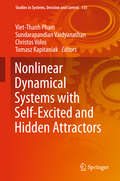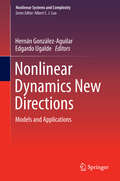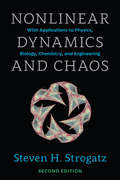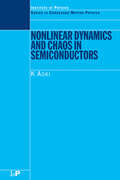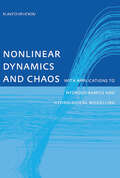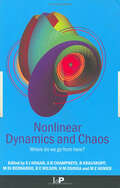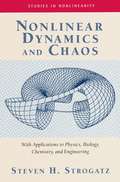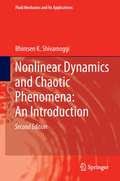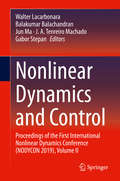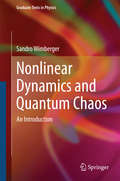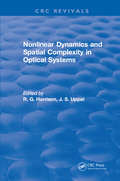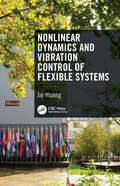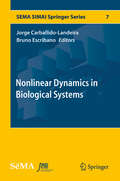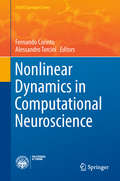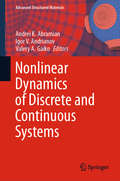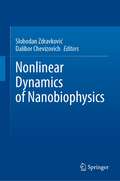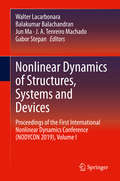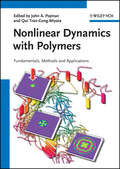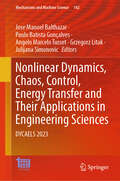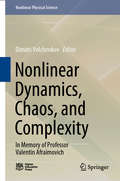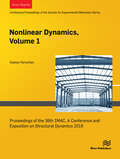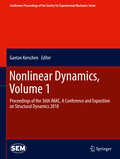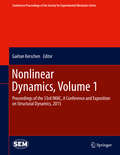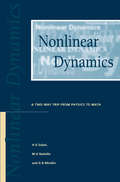- Table View
- List View
Nonlinear Dynamical Systems with Self-Excited and Hidden Attractors (Studies In Systems, Decision And Control #133)
by Sundarapandian Vaidyanathan Christos Volos Viet-Thanh Pham Tomasz KapitaniakThis book highlights the latest findings on nonlinear dynamical systems including two types of attractors: self-excited and hidden attractors. Further, it presents both theoretical and practical approaches to investigating nonlinear dynamical systems with self-excited and hidden attractors. The book includes 20 chapters contributed by respected experts, which focus on various applications such as biological systems, memristor-based systems, fractional-order systems, finance systems, business cycles, oscillators, coupled systems, hyperchaotic systems, flexible robot manipulators, electronic circuits, and control models. Special attention is given to modeling, design, circuit realization, and practical applications to address recent research problems in nonlinear dynamical systems.The book provides a valuable reference guide to nonlinear dynamical systems for engineers, researchers, and graduate students, especially those whose work involves mechanics, electrical engineering, and control systems.
Nonlinear Dynamics New Directions
by Hernán González-Aguilar Edgardo UgaldeThis book, along with its companion volume, Nonlinear Dynamics New Directions: Models and Applications, covers topics ranging from fractal analysis to very specific applications of the theory of dynamical systems to biology. This first volume is devoted to fundamental aspects and includes a number of important new contributions as well as some review articles that emphasize new development prospects. The second volume contains mostly new applications of the theory of dynamical systems to both engineering and biology. The topics addressed in the two volumes include a rigorous treatment of fluctuations in dynamical systems, topics in fractal analysis, studies of the transient dynamics in biological networks, synchronization in lasers, and control of chaotic systems, among others. This book also: · Presents a rigorous treatment of fluctuations in dynamical systems and explores a range of topics in fractal analysis, among other fundamental topics · Features recent developments on large deviations for higher-dimensional maps, a study of measures resisting multifractal analysis and a overview of complex Kleninan groups · Includes thorough review of recent findings that emphasize new development prospects
Nonlinear Dynamics and Chaos
by Steven H. StrogatzThis textbook is aimed at newcomers to nonlinear dynamics and chaos, especially students taking a first course in the subject. The presentation stresses analytical methods, concrete examples, and geometric intuition. The theory is developed systematically, starting with first-order differential equations and their bifurcations, followed by phase plane analysis, limit cycles and their bifurcations, and culminating with the Lorenz equations, chaos, iterated maps, period doubling, renormalization, fractals, and strange attractors. A unique feature of the book is its emphasis on applications. These include mechanical vibrations, lasers, biological rhythms, superconducting circuits, insect outbreaks, chemical oscillators, genetic control systems, chaotic waterwheels, and even a technique for using chaos to send secret messages. In each case, the scientific background is explained at an elementary level and closely integrated with mathematical theory. In the twenty years since the first edition of this book appeared, the ideas and techniques of nonlinear dynamics and chaos have found application to such exciting new fields as systems biology, evolutionary game theory, and sociophysics. This second edition includes new exercises on these cutting-edge developments, on topics as varied as the curiosities of visual perception and the tumultuous love dynamics in Gone With the Wind.
Nonlinear Dynamics and Chaos
by Steven H. StrogatzAn accessible and clearly-written introduction for first-time students of chaos and nonlinear systems, with plenty of examples, illustrations, and applications to science and engineering. The theory is developed systematically, starting with first-order differential equations and their bifurcations, followed by phase plane analysis, limit cycles and their bifurcations, and culminating with the Lorenz equations, chaos, iterated maps, period doubling, renormalization, fractals, and strange attractors.
Nonlinear Dynamics and Chaos in Semiconductors (Condensed Matter Physics)
by K AokiThe field of nonlinear dynamics and low-dimensional chaos has developed rapidly over the past twenty years. The principal advances have been in theoretical aspects but more recent applications in a wide variety of the sciences have been made. Nonlinear Dynamics and Chaos in Semiconductors is the first book to concentrate on specific physical and ex
Nonlinear Dynamics and Chaos with Applications to Hydrodynamics and Hydrological Modelling
by Slavco VelickovThe theory of nonlinear dynamics and chaos, and the extent to which recent improvements in the understanding of inherently nonlinear natural processes present challenges to the use of mathematical models in the analysis of water and environmental systems, are elaborated in this work.
Nonlinear Dynamics and Chaos: Where do we go from here?
by Mario Di Bernardo John Hogan Bernd Krauskopf Eddie Wilson Alan Champneys Hinke Osinga Martin HomerNonlinear dynamics has been successful in explaining complicated phenomena in well-defined low-dimensional systems. Now it is time to focus on real-life problems that are high-dimensional or ill-defined, for example, due to delay, spatial extent, stochasticity, or the limited nature of available data. How can one understand the dynamics of such sys
Nonlinear Dynamics and Chaos: With Applications to Physics, Biology, Chemistry, and Engineering, Second Edition
by Steven H. StrogatzThis textbook is aimed at newcomers to nonlinear dynamics and chaos, especially students taking a first course in the subject. The presentation stresses analytical methods, concrete examples and geome
Nonlinear Dynamics and Chaotic Phenomena: An Introduction
by Bhimsen K. ShivamoggiThis book starts with a discussion of nonlinear ordinary differential equations, bifurcation theory and Hamiltonian dynamics. It then embarks on a systematic discussion of the traditional topics of modern nonlinear dynamics -- integrable systems, Poincaré maps, chaos, fractals and strange attractors. The Baker's transformation, the logistic map and Lorenz system are discussed in detail in view of their central place in the subject. There is a detailed discussion of solitons centered around the Korteweg-deVries equation in view of its central place in integrable systems. Then, there is a discussion of the Painlevé property of nonlinear differential equations which seems to provide a test of integrability. Finally, there is a detailed discussion of the application of fractals and multi-fractals to fully-developed turbulence -- a problem whose understanding has been considerably enriched by the application of the concepts and methods of modern nonlinear dynamics. On the application side, there is a special emphasis on some aspects of fluid dynamics and plasma physics reflecting the author's involvement in these areas of physics. A few exercises have been provided that range from simple applications to occasional considerable extension of the theory. Finally, the list of references given at the end of the book contains primarily books and papers used in developing the lecture material this volume is based on. This book has grown out of the author's lecture notes for an interdisciplinary graduate-level course on nonlinear dynamics. The basic concepts, language and results of nonlinear dynamical systems are described in a clear and coherent way. In order to allow for an interdisciplinary readership, an informal style has been adopted and the mathematical formalism has been kept to a minimum. This book is addressed to first-year graduate students in applied mathematics, physics, and engineering, and is useful also to any theoretically inclined researcher in the physical sciences and engineering. This second edition constitutes an extensive rewrite of the text involving refinement and enhancement of the clarity and precision, updating and amplification of several sections, addition of new material like theory of nonlinear differential equations, solitons, Lagrangian chaos in fluids, and critical phenomena perspectives on the fluid turbulence problem and many new exercises.
Nonlinear Dynamics and Control: Proceedings of the First International Nonlinear Dynamics Conference (NODYCON 2019), Volume II
by Jun Ma Walter Lacarbonara J. A. Tenreiro Machado Balakumar Balachandran Gabor StepanThis second of three volumes from the inaugural NODYCON, held at the University of Rome, in February of 2019, presents papers devoted to Nonlinear Dynamics and Control. The collection features both well-established streams of research as well as novel areas and emerging fields of investigation. Topics in Volume II include influence of nonlinearities on vibration control systems; passive, semi-active, active control of structures and systems; synchronization; robotics and human-machine interaction; network dynamics control (multi-agent systems, leader-follower dynamics, swarm dynamics, biological networks dynamics); and fractional-order control.
Nonlinear Dynamics and Quantum Chaos
by Sandro WimbergerThe field of nonlinear dynamics and chaos has grown very much over the last few decades and is becoming more and more relevant in different disciplines. This book presents a clear and concise introduction to the field of nonlinear dynamics and chaos, suitable for graduate students in mathematics, physics, chemistry, engineering, and in natural sciences in general. It provides a thorough and modern introduction to the concepts of Hamiltonian dynamical systems' theory combining in a comprehensive way classical and quantum mechanical description. It covers a wide range of topics usually not found in similar books. Motivations of the respective subjects and a clear presentation eases the understanding. The book is based on lectures on classical and quantum chaos held by the author at Heidelberg University. It contains exercises and worked examples, which makes it ideal for an introductory course for students as well as for researchers starting to work in the field.
Nonlinear Dynamics and Spatial Complexity in Optical Systems (Scottish Graduate Ser. #41)
by R. G. HarrisonA collection of prestigious postgraduate lectures, Nonlinear Dynamics and Spatial Complexity in Optical Systems reviews developments in the theory and practice of nonlinear dynamics and structural complexity, and explores modern-day applications in nonlinear optics. The book addresses systems including both singlemode and multimode lasers, bistable and multistable devices, optical fibers, counter-propagating beam interactions, nonlinear mixing, and related optical phenomena.
Nonlinear Dynamics and Vibration Control of Flexible Systems
by JIE HUANGThis book is an essential guide to nonlinear dynamics and vibration control, detailing both the theory and the practical industrial applications within all aspects of engineering. Demonstrating how to improve efficiency through reducing unwanted vibration, it will aid both students and engineers in practically and safely improving flexible structures through control methods. Increasing demand for light-weight robotic systems and space applications has actuated the design and construction of more flexible structures. These flexible structures, involving numerous dynamic systems, experience unwanted vibrations, impacting accuracy, operating speed, safety and, importantly, efficiency. This book aids engineers in assuaging this issue through vibration control methods, including nonlinear dynamics. It covers topics such as dynamic modeling of nonlinear system, nonlinear oscillators, and modal analyses of multiple-mode system. It also looks at vibration control methods including linear control, nonlinear control, intelligent control, and command smoothers. These control methods are effective and reliable methods to counteract unwanted vibrations. The book is practically minded, using industrial applications throughout, such as bridge cranes, tower cranes, aerial cranes and liquid sloshing. It also discusses cable-suspension structures, light-weight links, and fluid motions which exhibit flexible-structure dynamics. The book will be of interest to students and engineers alike, in the field of mechatronics, mechanical systems and signal processing, nonlinear dynamics, vibration, and control engineering.
Nonlinear Dynamics in Biological Systems
by Jorge Carballido-Landeira Bruno EscribanoThis book presents recent researchresults relating to applications of nonlinear dynamics, focusing specificallyon four topics of wide interest: heart dynamics, DNA/RNA, cell mobility, andproteins. The book derives from the First BCAM Workshop on Nonlinear Dynamicsin Biological Systems, held in June 2014 at the Basque Center of AppliedMathematics (BCAM). At this international meeting, researchers from differentbut complementary backgrounds, including molecular dynamics, physical chemistry,bio-informatics and biophysics, presented their most recent results anddiscussed the future direction of their studies using theoretical, mathematicalmodeling and experimental approaches. Such was the level of interest stimulatedthat the decision was taken to produce this publication, with the organizers ofthe event acting as editors. All of the contributing authors are researchers workingon diverse biological problems that can be approached using nonlinear dynamics. The book will appeal especially to applied mathematicians, biophysicists, andcomputational biologists.
Nonlinear Dynamics in Computational Neuroscience (PoliTO Springer Series)
by Fernando Corinto Alessandro TorciniThis book provides an essential overview of computational neuroscience. It addresses a broad range of aspects, from physiology to nonlinear dynamical approaches to understanding neural computation, and from the simulation of brain circuits to the development of engineering devices and platforms for neuromorphic computation. Written by leading experts in such diverse fields as neuroscience, physics, psychology, neural engineering, cognitive science and applied mathematics, the book reflects the remarkable advances that have been made in the field of computational neuroscience, an emerging discipline devoted to the study of brain functions in terms of the information-processing properties of the structures forming the nervous system. The contents build on the workshop “Nonlinear Dynamics in Computational Neuroscience: from Physics and Biology to ICT,” which was held in Torino, Italy in September 2015.
Nonlinear Dynamics of Discrete and Continuous Systems (Advanced Structured Materials #139)
by Igor V. Andrianov Andrei K. Abramian Valery A. GaikoThis book commemorates the 60th birthday of Dr. Wim van Horssen, a specialist in nonlinear dynamic and wave processes in solids, fluids and structures. In honor of Dr. Horssen’s contributions to the field, it presents papers discussing topics such as the current problems of the theory of nonlinear dynamic processes in continua and structures; applications, including discrete and continuous dynamic models of structures and media; and problems of asymptotic approaches.
Nonlinear Dynamics of Nanobiophysics
by Slobodan Zdravković Dalibor ChevizovichThis book highlights important aspects of nonlinear dynamics of biophysical nanosystems, such as DNA, alpha helix, and microtubules. It presents the differences between the linear and nonlinear models in these molecules and includes interesting chapters on Soliton dynamics of the DNA molecule. This book is meant not only for researchers but also for both graduate and undergraduate students. Chapters include derivations, detailed explanations, and exercises for students. Therefore, the book is convenient to be used as a textbook in suitable courses.
Nonlinear Dynamics of Structures, Systems and Devices: Proceedings of the First International Nonlinear Dynamics Conference (NODYCON 2019), Volume I
by Jun Ma Walter Lacarbonara J. A. Tenreiro Machado Balakumar Balachandran Gabor StepanThis first of three volumes from the inaugural NODYCON, held at the University of Rome, in February of 2019, presents papers devoted to Nonlinear Dynamics of Structures, Systems and Devices. The collection features both well-established streams of research as well as novel areas and emerging fields of investigation. Topics in Volume I include multi-scale dynamics: coexistence of multiple time/space scales, large system dynamics; dynamics of structures/industrial machines/equipment/facilities (e.g., cable transportation systems, suspension bridges, cranes, vehicles); nonlinear interactions: parametric vibrations with single/multi-frequency excitations, multiple external and autoparametric resonances in multi-dof systems; nonlinear system identification: parametric/nonparametric identification, data-driven identification; experimental dynamics: benchmark experiments, experimental methods, instrumentation techniques, measurements in harsh environments, experimental validation of nonlinear models; wave propagation, solitons, kinks, breathers; solution methods for pdes: Lie groups, Hirota’s method, perturbation methods, etc; nonlinear waves in media (granular materials, porous materials, materials with memory); composite structures: multi-layer, functionally graded, thermal loading; fluid/structure interaction; nonsmooth and retarded dynamics: systems with impacts, free play, stick-slip, friction hysteresis; nonlinear systems with time and/or space delays; stability of delay differential equations, differential-algebraic equations; space/time reduced-order modeling: enhanced discretization methods, center manifold reduction, nonlinear normal modes, normal forms; fractional-order systems; computational techniques: efficient algorithms, use of symbolic manipulators, integration of symbolic manipulation and numerical methods, use of parallel processors; and multibody dynamics: rigid and flexible multibody system dynamics, impact and contact mechanics, tire modeling, railroad vehicle dynamics, computational multibody dynamics.
Nonlinear Dynamics with Polymers: Fundamentals, Methods and Applications
by John A. PojmanClosing a gap in the literature, this is the first comprehensive handbook on this modern and important polymer topic. Edited by highly experienced and top scientists in the field, this ready reference covers all aspects, including material science, biopolymers, gels, phase separating systems, frontal polymerization and much more. The introductory chapter offers the perfect starting point for the non-expert.
Nonlinear Dynamics, Chaos, Control, Energy Transfer and Their Applications in Engineering Sciences: DYCAELS 2023 (Mechanisms and Machine Science #142)
by Jose Manoel Balthazar Paulo Batista Gonçalves Angelo Marcelo Tusset Grzegorz Litak Julijana SimonovicThe book gathers review papers in emergent engineering applications and new horizons in nonlinear dynamics, and originates from DYCAELS 2023, the IV Conference on Dynamics, Control and Applications to Applied Engineering and Life Science, which was held in Ponta Grossa, Brazil, on November 6-11, 2023. The contributions cover diverse topics such as linear and nonlinear control, vibro-impact systems, energy harvesting, robotics, bioengineering, flexible structures, non-ideal excitation, aeroelastic instabilities, new materials, synchronization, stochastic dynamics, multistable systems, nonstationary dynamics and different time scales, wave propagation, chaotic dynamics and mechanisms and machine science.
Nonlinear Dynamics, Chaos, and Complexity: In Memory of Professor Valentin Afraimovich (Nonlinear Physical Science)
by Dimitri VolchenkovThis book demonstrates how mathematical methods and techniques can be used in synergy and create a new way of looking at complex systems. It becomes clear nowadays that the standard (graph-based) network approach, in which observable events and transportation hubs are represented by nodes and relations between them are represented by edges, fails to describe the important properties of complex systems, capture the dependence between their scales, and anticipate their future developments. Therefore, authors in this book discuss the new generalized theories capable to describe a complex nexus of dependences in multi-level complex systems and to effectively engineer their important functions. The collection of works devoted to the memory of Professor Valentin Afraimovich introduces new concepts, methods, and applications in nonlinear dynamical systems covering physical problems and mathematical modelling relevant to molecular biology, genetics, neurosciences, artificial intelligence as well as classic problems in physics, machine learning, brain and urban dynamics. The book can be read by mathematicians, physicists, complex systems scientists, IT specialists, civil engineers, data scientists, urban planners, and even musicians (with some mathematical background).
Nonlinear Dynamics, Volume 1: Proceedings of the 36th IMAC, A Conference and Exposition on Structural Dynamics 2018
by Gaetan KerschenNonlinear Dynamics, Volume 1: Proceedings of the 36th IMAC, A Conference and Exposition on Structural Dynamics, 2018, the first volume of nine from the Conference brings together contributions to this important area of research and engineering. The collection presents early findings and case studies on fundamental and applied aspects of Nonlinear Dynamics, including papers on: Nonlinear System Identification Nonlinear Modeling & Simulation Nonlinear Reduced-order Modeling Nonlinearity in PracticeNonlinearity in Aerospace Systems Nonlinearity in Multi-Physics Systems Nonlinear Modes and Modal Interactions Experimental Nonlinear Dynamics.
Nonlinear Dynamics, Volume 1: Proceedings of the 36th IMAC, A Conference and Exposition on Structural Dynamics 2018 (Conference Proceedings of the Society for Experimental Mechanics Series)
by Gaetan KerschenNonlinear Dynamics, Volume 1: Proceedings of the 36th IMAC, A Conference and Exposition on Structural Dynamics, 2018, the first volume of nine from the Conference brings together contributions to this important area of research and engineering. The collection presents early findings and case studies on fundamental and applied aspects of Nonlinear Dynamics, including papers on: Nonlinear System IdentificationNonlinear Modeling & SimulationNonlinear Reduced-order ModelingNonlinearity in PracticeNonlinearity in Aerospace SystemsNonlinearity in Multi-Physics SystemsNonlinear Modes and Modal InteractionsExperimental Nonlinear Dynamics
Nonlinear Dynamics, Volume 2
by Gaetan KerschenThis second volume of eight from the IMAC - XXXII Conference, brings together contributions to this important area of research and engineering. The collection presents early findings and case studies on fundamental and applied aspects of Structural Dynamics, including papers on: Linear Systems Substructure Modelling Adaptive Structures Experimental Techniques Analytical Methods Damage Detection Damping of Materials & Members Modal Parameter Identification Modal Testing Methods System Identification Active Control Modal Parameter Estimation Processing Modal Data
Nonlinear Dynamics: A Two-Way Trip from Physics to Math
by H.G SolariNonlinear Dynamics: A Two-Way Trip from Physics to Math provides readers with the mathematical tools of nonlinear dynamics to tackle problems in all areas of physics. The selection of topics emphasizes bifurcation theory and topological analysis of dynamical systems. The book includes real-life problems and experiments as well as exercises and work
